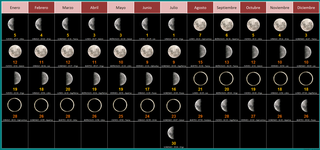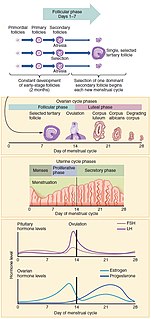
A bicycle, also called a bike or cycle, is a human-powered or motor-powered, pedal-driven, single-track vehicle, having two wheels attached to a frame, one behind the other. A bicycle rider is called a cyclist, or bicyclist.

Cycling, also called bicycling or biking, is the use of bicycles for transport, recreation, exercise or sport. People engaged in cycling are referred to as "cyclists", "bicyclists", or "bikers". Apart from two-wheeled bicycles, "cycling" also includes the riding of unicycles, tricycles, quadricycles, recumbent and similar human-powered vehicles (HPVs).

The citric acid cycle (CAC) – also known as the TCA cycle or the Krebs cycle – is a series of chemical reactions used by all aerobic organisms to release stored energy through the oxidation of acetyl-CoA derived from carbohydrates, fats, and proteins. In addition, the cycle provides precursors of certain amino acids, as well as the reducing agent NADH, that are used in numerous other reactions. Its central importance to many biochemical pathways suggests that it was one of the earliest components of metabolism and may have originated abiogenically. Even though it is branded as a 'cycle', it is not necessary for metabolites to follow only one specific route; at least three segments of the citric acid cycle have been recognized.

The cell cycle, or cell-division cycle, is the series of events that take place in a cell that cause it to divide into two daughter cells. These events include the duplication of its DNA and some of its organelles, and subsequently the partitioning of its cytoplasm and other components into two daughter cells in a process called cell division.

The hertz (symbol: Hz) is the derived unit of frequency in the International System of Units (SI) and is defined as one cycle per second. It is named after Heinrich Rudolf Hertz, the first person to provide conclusive proof of the existence of electromagnetic waves. Hertz are commonly expressed in multiples: kilohertz (103 Hz, kHz), megahertz (106 Hz, MHz), gigahertz (109 Hz, GHz), terahertz (1012 Hz, THz), petahertz (1015 Hz, PHz), exahertz (1018 Hz, EHz), and zettahertz (1021 Hz, ZHz).

A lunar calendar is a calendar based on the monthly cycles of the Moon's phases, in contrast to solar calendars, whose annual cycles are based only directly on the solar year. The most commonly used calendar, the Gregorian calendar, is a solar calendar system that originally evolved out of a lunar calendar system. A purely lunar calendar is also distinguished from a lunisolar calendar, whose lunar months are brought into alignment with the solar year through some process of intercalation. The details of when months begin varies from calendar to calendar, with some using new, full, or crescent moons and others employing detailed calculations.

Track cycling is a bicycle racing sport usually held on specially built banked tracks or velodromes using track bicycles.

The menstrual cycle is the regular natural change that occurs in the female reproductive system that makes pregnancy possible. The cycle is required for the production of oocytes, and for the preparation of the uterus for pregnancy. The menstrual cycle occurs due to the rise and fall of estrogen. This cycle results in the thickening of the lining of the uterus, and the growth of an egg,. The egg is released from an ovary around day fourteen in the cycle; the thickened lining of the uterus provides nutrients to an embryo after implantation. If pregnancy does not occur, the lining is released in what is known as menstruation or a "period".

The business cycle, also known as the economic cycle or trade cycle, are the fluctuations of gross domestic product (GDP) around its long-term growth trend. The length of a business cycle is the period of time containing a single boom and contraction in sequence. These fluctuations typically involve shifts over time between periods of relatively rapid economic growth and periods of relative stagnation or decline.

The water cycle, also known as the hydrologic cycle or the hydrological cycle, describes the continuous movement of water on, above and below the surface of the Earth. The mass of water on Earth remains fairly constant over time but the partitioning of the water into the major reservoirs of ice, fresh water, saline water and atmospheric water is variable depending on a wide range of climatic variables. The water moves from one reservoir to another, such as from river to ocean, or from the ocean to the atmosphere, by the physical processes of evaporation, condensation, precipitation, infiltration, surface runoff, and subsurface flow. In doing so, the water goes through different forms: liquid, solid (ice) and vapor.

Sexual attraction is attraction on the basis of sexual desire or the quality of arousing such interest. Sexual attractiveness or sex appeal is an individual's ability to attract the sexual or erotic interests of other people, and is a factor in sexual selection or mate choice. The attraction can be to the physical or other qualities or traits of a person, or to such qualities in the context where they appear. The attraction may be to a person's aesthetics or movements or to their voice or smell, besides other factors. The attraction may be enhanced by a person's adornments, clothing, perfume or style. It can be influenced by individual genetic, psychological, or cultural factors, or to other, more amorphous qualities. Sexual attraction is also a response to another person that depends on a combination of the person possessing the traits and on the criteria of the person who is attracted.

The Ox (牛) is the second of the 12-year periodic sequence (cycle) of animals which appear in the Chinese zodiac related to the Chinese calendar, and also appears in related calendar systems. The Chinese term translated here as ox is in Chinese niú (牛), a word generally referring to cows, bulls, or neutered types of the bovine family, such as common cattle or water buffalo. The zodiacal ox may be construed as male, female, neuter, and either singular or plural. The Year of the Ox is also denoted by the Earthly Branch symbol chǒu (丑). The term "zodiac" ultimately derives from an Ancient Greek term referring to a "circle of little animals". There are also a yearly month of the ox and a daily hour of the ox. Years of the oxen (cows) are cyclically differentiated by correlation to the Heavenly Stems cycle, resulting in a repeating cycle of five years of the ox/cow, each ox/cow year also being associated with one of the Chinese wǔxíng, also known as the "five elements", or "phases": the "Five Phases" being Fire, Water, Wood, Metal, and Earth. The Year of the Ox follows after the Year of the Rat and it is followed by the Year of the Tiger.

In ecology and Earth science, a biogeochemical cycle or substance turnover or cycling of substances is a pathway by which a chemical substance moves through biotic (biosphere) and abiotic compartments of Earth. There are biogeochemical cycles for the chemical elements calcium, carbon, hydrogen, mercury, nitrogen, oxygen, phosphorus, selenium, iron and sulfur; molecular cycles for water and silica; macroscopic cycles such as the rock cycle; as well as human-induced cycles for synthetic compounds such as polychlorinated biphenyl (PCB). In some cycles there are reservoirs where a substance remains for a long period of time.
The sexagenary cycle, also known as the Stems-and-Branches or ganzhi, is a cycle of sixty terms, each corresponding to one year, thus a total of sixty years for one cycle, historically used for reckoning time in China and the rest of the East Asian cultural sphere. It appears as a means of recording days in the first Chinese written texts, the Shang oracle bones of the late second millennium BC. Its use to record years began around the middle of the 3rd century BC. The cycle and its variations have been an important part of the traditional calendrical systems in Chinese-influenced Asian states and territories, particularly those of Japan, Korea, and Vietnam, with the old Chinese system still in use in Taiwan, and to a lesser extent, in Mainland China.

A combined cycle power plant is an assembly of heat engines that work in tandem from the same source of heat, converting it into mechanical energy. On land, when used to make electricity the most common type is called a combined cycle gas turbine (CCGT) plant. The same principle is also used for marine propulsion, where it is called a combined gas and steam (COGAS) plant. Combining two or more thermodynamic cycles improves overall efficiency, which reduces fuel costs.

America's Next Top Model is an American reality television series and interactive competition in which a number of aspiring models compete for the title of "America's Next Top Model" and a chance to begin their career in the modeling industry. Created by Tyra Banks, who also serves as an executive producer, and developed by Ken Mok and Kenya Barris, the series premiered in May 2003, and aired semiannually until 2012, then annually from 2013. The first six seasons aired on UPN, before UPN merged with The WB to create The CW in 2006. The following sixteen cycles aired on The CW until the series was first cancelled in October 2015. The series was revived in 2016 and has been airing on VH1 ever since. The series was among the highest-rated programs on UPN and was the highest-rated show on The CW from 2007 to 2010. Advertisers paid $61,315 per 30-second slot during the 2011–12 television season, the highest of any series on The CW. The first 22 cycles of the series and cycle 24 were presented by Banks, while cycle 23 was presented by Rita Ora. The series also employs a panel of two or three additional judges, a creative director and a runway coach.

Cycle sport is competitive physical activity using bicycles. There are several categories of bicycle racing including road bicycle racing, time trialling, cyclo-cross, mountain bike racing, track cycling, BMX, and cycle speedway. Non-racing cycling sports include artistic cycling, cycle polo, freestyle BMX and mountain bike trials. The Union Cycliste Internationale (UCI) is the world governing body for cycling and international competitive cycling events. The International Human Powered Vehicle Association is the governing body for human-powered vehicles that imposes far fewer restrictions on their design than does the UCI. The UltraMarathon Cycling Association is the governing body for many ultra-distance cycling races.
The estrous cycle or oestrous cycle is the set of recurring physiological changes that are induced by reproductive hormones in most mammalian therian females. Estrous cycles start after sexual maturity in females and are interrupted by anestrous phases or by pregnancies. Typically, estrous cycles repeat until death. Some animals may display bloody vaginal discharge, often mistaken for menstruation.
In the context of an internal combustion engine, the term stroke has the following related meanings

In hydrology, the inflow of a body of water is the source of the water within the body of water. It can also refer to the average volume of incoming water in unit time. It is contrasted with outflow.
















